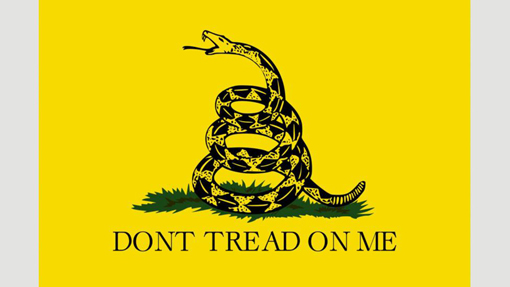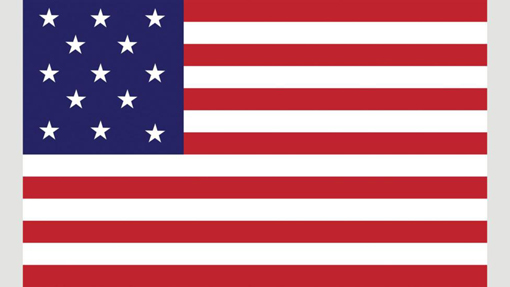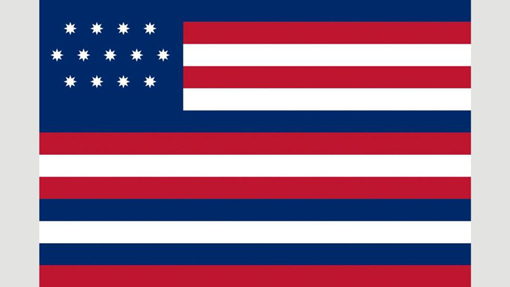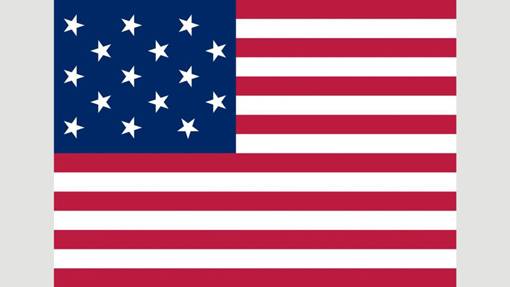You are hereBlogs / WcP.Story.Teller's blog / Eight US flags that could have been: Grand Union, Liberty Tree, Betsy Ross, Don’t Tread on Me, Serapis...
Eight US flags that could have been: Grand Union, Liberty Tree, Betsy Ross, Don’t Tread on Me, Serapis...

1. Grand Union Flag, 1775
(quote)
When, on 1 January 1776, Washington’s Continental Army was mustered formally on Prospect Hill (Mount Pisgah) in Somerville, Massachusetts, it was under this flag favoured by the American general during the previous year’s Siege of Boston. John Paul Jones, the first well-known American admiral raised the Grand Union Flag at sea in December 1775. The Grand Union Flag was an adaptation of the British Red Ensign, with six white stripes overlain on the red backdrop to create thirteen alternating red-and-white stripes symbolising the first states of the American union.

2. Liberty Tree flag, 1775
The lofty white pines of New England were much prized by the Royal Navy for the construction of its grandest warships. Dating from the Massachusetts Charter of 1691, prize specimens were marked with a broad arrow symbol denoting property of the Crown and shipped to England. This form of compulsory purchase led to the Pine Tree Riot of 1772, a precursor to the famous Boston Tea Party of 1774 and war with Great Britain a year later.
Flown from the masts of American warships, the Pine Tree flag was a powerful symbolic riposte to the Crown and its Royal Navy. A lone pine was shown on a white background with the inscription "An Appeal to Heaven" ("An Appeal to God" was a less common alternative). These words were taken from the British philosopher John Locke’s Second Treatise on Civil Government (1690), which refuted the notion of the Divine Right of Kings.

3. The Betsy Ross, 1776 (or not)
The earliest known example of this flag, with its neat and modern-looking circle of 13 five-pointed stars, appears to date from 1792 in a painting begun that year, George Washington before the Battle of Trenton, by John Trumbull. The battle took place in 1776 and so, perhaps, the Betsy Ross was the first all-American flag. No one knows for sure and this early Continental flag, still flown today on many occasions, remains the stuff of legend. It is said to have been designed and made by Betsy Ross, a Philadelphia seamstress and upholsterer well known to George Washington. The story was told years later by Ross’s grandson William Canby.

4. Don’t Tread on Me or The Gadsden Flag, 1776
Approved by Congress and depicting a coiled rattle snake ready to strike on a yellow background above the legend "Don’t Tread on Me", this unusual flag was probably first flown by Commodore Esek Hopkins in February 1776 on a naval raid against the British outpost of Nassau in the Bahamas. On land, it was popularised by Brigadier General Christopher Gadsden of South Carolina, who may well have designed it. Along with the Bald Eagle, the rattlesnake was a symbol of the American colonies: its rattle has thirteen layers, one for each of the original United States. Writing for the Pennsylvania Gazette in 1751, Benjamin Franklin suggested that in retaliation against Britain sending convicted criminals to America, America would return the favour with rattlesnakes. Eclipsed by the Stars and Stripes, the Gadsden Flag has regained popularity recently with libertarian groups - notably the Tea Party - alongside US soccer supporter groups.

5. US Navy Flag, 1777
On 14 June 1777, the Second Continental Congress resolved "that the flag of the thirteen United States be thirteen stripes, alternate red and white; that the union be thirteen stars, white in a blue field, representing a new constellation." Although a flag bearing a strong resemblance to today’s Star-Spangled Banner was designed by Francis Hopkinson, a New Jersey lawyer and signatory of the Declaration of Independence, this was primarily for the US Navy.

6. Serapis flag, 1779
In those early days when the US flag had yet to be established, many featured red, white and blue stripes. The most famous of these is the Serapis flag of 1779 flown from the captured British frigate of that name by US Captain John Paul Jones. In battle, the ensign of the British ship had been blown away. When Jones sailed her, flagless and in need of repair, into the island port of Texel, run by the neutral Dutch United Provinces, British officials declared the Serapis a pirate ship. This was a dangerous moment for Jones.
Based, perhaps, on knowledge of a letter from Benjamin Franklin and John Adams of 3 October 1778 to Ferdinand I of the Two Sicilies describing the American flag as consisting of "13 stripes, alternately red, white and blue", Jones had such a design run up. The original sketch survives in Dutch records.

7. The Star-Spangled Banner, 1795
This enormous flag, measuring 42ft by 30ft (13m by 9m), flew over Fort McHenry during the Battle of Baltimore in 1812. The Americans were victorious, while the sight of the Stars and Stripes waving over the besieged fort prompted Francis Scott Key, lawyer and poet, to write The Defence of Fort McHenry. Its famous verses became The Star-Spangled Banner, from 1931 the National Anthem of the United States:
"O say does that star-spangled banner yet wave
O'er the land of the free and the home of the brave?"
Curiously, perhaps, this most famous of US flags - on display in the Museum of American History, Washington DC today - boasts 15 rather than 13 stripes, while the anthem it encouraged is sung to a British melody composed by John Stafford Smith, organist of the Chapel Royal, London. Smith had written his music to accompany To Anacreon in Heaven,a London club’s drinking song.

8. Confederate Navy Flag, 1863
By 1861, the US flag was very much what is today. Something, though, was about to threaten the very identity of the United States. This, of course, was the American Civil War (1861-65). Where the Union states flew the Stars and Stripes, the Confederate states raised a number of distinctive flags adorned with 13 stars of their own set in circles or, more recognisably today, within a blue saltire cross on a red background. The Confederacy produced a wide range of flags, although the best known is based either on the Second Confederate Navy Jack or the Battle Flag of Northern Virginia. The Southern Cross is a reminder of how the course of US history might have been very different. And, although they cannot ignore the rulings of the US Supreme Court, laws in Florida, Georgia, Louisiana, Mississippi and South Carolina protect the Confederate flag from mutilation, defamation and contempt.
(unquote)
Original source and image courtesy BBC



















Thanks for sharing. Your article is awesome! How long does it take to complete this article? I have read through other blogs, but they are cumbersome and confusing.
amazing story.. thanks for sharing
- anirudh
Hmm. The second and the 8th variants are referred to faith, "An Appeal to Heaven" is clear, and isn't the Confederate Navy Flag represents the cross of St. Andrew the First Called (if it was without the starts), on which he was crucified? By the way the Russian's navy has a very similar flag but in white and blue. Who knows what it can mean? Perhaps that all sailors are first and foremost brothers in Christ. Anyway (let me jump from here )as for the Confederation flag and monuments, what is the good of removing the statues and rewriting history? Let our children know like it was, all are humans, so we made mistakes in history, and it's normal.
So, the second and the 8th variants are referred to faith, "An Appeal to Heaven" is clear, and isn't the Confederate Navy Flag represents the cross of St. Andrew the First Called (if it was without the starts), on which he was crucified? By the way the Russian's navy has a very similar flag but in white and blue. Who knows what it can mean? Perhaps that all sailors are first and foremost brothers in Christ. Anyway (let me jump from here )as for the Confederation flag and monuments, what is the good of removing the statues and rewriting history? Let our children know like it was, all are humans, so we made mistakes in history, and it's normal.
Thanks for the information your article brings. I see the novelty of your writing, I will share it for everyone to read together. I look forward to reading many articles from you.